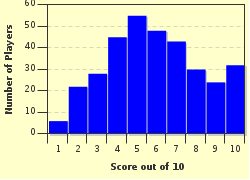Quiz Answer Key and Fun Facts
1. In 1905 discontent was rife in the Russian countryside as well as the cities. Many peasants were starving due poor agricultural techniques and remained landless, merely working on the land of absent nobles. On top of this, workers had to endure long hours in dreadful conditions and national minorities began to demand self-government following the Tsar's policy of "Russification". With such poor class relations, the Tsar and his advisors made a vain attempt to boost morale with the victory in an "easy war". Which country was involved in this war with Russia from January 1904 to August 1905?
2. In response to the problems of the working class, what started out as a peaceful protest turned into a massacre as many demonstrators were killed by the panicked police force that opened fire on the hymn singing crowd. Although not present during what became known as "Bloody Sunday" in January 1905, Tsar Nicholas II was hugely discredited. Who led this "peaceful protest" which is seen as the start of the 1905 revolution?
3. With mass unrest and violence from almost every class in Russia it would seem a miracle that the Tsar survived 1905. However, the fact was that for many the 1905 revolution was not a case of overthrowing the Tsar, but rather improving the living conditions in Russia. Furthermore, with different classes having different demands the revolution lacked unity, making it easier for the Tsar's administration to placate the masses. Which piece of legislation in 1905 seemingly offered great concessions to the Russian people?
4. Once again under the obstinate autocratic thumb of the Tsar, any attempts at an uprising were violently crushed by the still loyal armed forces. However, with bitter disappointments over political reform along with the effects of World War I severe discontent again clearly surfaced in 1917. Which of these was NOT an issue leading to the February Revolution?
5. In terms of violent unrest in Russia, the February Revolution did not compare to that in 1905. The real difference of this revolution in bringing about radical change was the loss of support for the Tsar from the "elites" and the army. World War I acted as a catalyst for the disposal of the Tsar as many loyal high ranking officers had been killed in battle (due to lack of preparation and supplies of the Russian army). For which of the following reasons did the nobles feel the Tsar should step down?
6. By 1917 the Tsar's own family had started planning his replacement. However, the Tsar accepted his abdication tamely after his train was intercepted by mutinous soldiers 100 miles from Petrograd. Although made official on February 28th, which man (President of the Duma) announced the abdication of the Tsar to the public on March 2nd?
7. A "dual power" came to rule Russia. This consisted of the Provisional Government and the Petrograd Soviet. Although having the power due to strong support from workers and soldiers, the Soviet allowed the Provisional Government to rule Russia during this period. This was done for several reasons. Which of the following is NOT one of those reasons?
8. Many problems remained unsolved from the Tsarist regime. The moderate socialists seemed incapable of improving working conditions in the cities, managing the issue of nationalist minorities and solving the issue of who should own the land in the countryside. The main issue however was the war itself. The Provisional Government believed that Russia should remain in the war and decided that a large offensive should be launched in order to force a German defeat. Also known as the "Kerensky Offensive", which attack in 1917 failed miserably, weakening the Russian army?
9. One of the actions of the "dual government" was the freeing of all political prisoners. This allowed for the return of Lenin. Upon Lenin's arrival he was horrified to see the co-operation of the Soviet with the moderate socialists in the Provisional Government. Lenin mounted an armoured car, declaring an end to co-operation with the Provisional Government, that all land should be given to the peasants, that the war should be ended and that power should be taken by the soviets. What were these demands collectively known as?
10. On the 25/26th of October 1917 the Bolsheviks (Lenin's party) are said to have stormed the Winter Palace while the Provisional Government were in session and overthrowing them to become the dominant force in Russia. In reality this was a low key affair but its result was very significant as the Bolsheviks did become the ruling party in Russia. This could only be done after the sudden rise in support for the Soviet and decline in support for the Provisional Government. Which event was the key factor in allowing this to happen?
Source: Author
doublemm
This quiz was reviewed by FunTrivia editor
bloomsby before going online.
Any errors found in FunTrivia content are routinely corrected through our feedback system.

